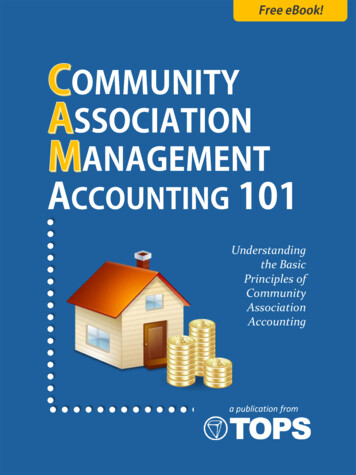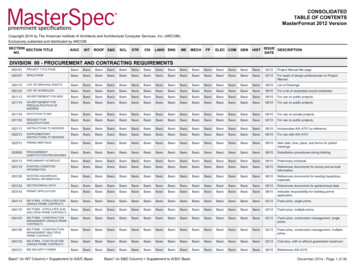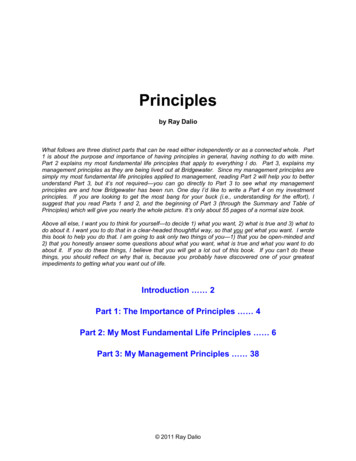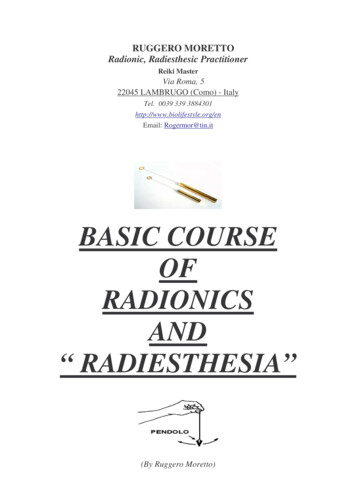
Transcription
Understandingthe BasicPrinciples ofCommunityAssociationAccountinga publication from
Community Association Accounting 101Table of ContentsChapter 1:Compare and Contrast7Chapter 2:CAM Accounting is Unique12Chapter 3:Choosing an Accounting Method19Chapter 4:Setting up the General LedgerChapter 5:The Accounting Cycle2633Chapter 6:Monthly Board Financial Reports383
Community Association Accounting 101About the AuthorsNancy Marry is the Technical Support Team Lead for TOPSSoftware. Her background in goods and servicesaccounting provided the inspiration for an article on HowGoods & Services Accounting Differs from CAMAccounting, which in turn inspired this eBook.Jeff Hardy is the founder of TOPS Software. As a formerfortune 500 corporate accountant and successfulmanagement company owner, Jeff has had his feet in bothaccounting and community management worlds. Hebrings his decades of knowledge and experience to thisand every project in which he is involved. Follow Jeff onTwiter @JeffHardy TOPSAndrea Drennen is the Marketing Manager for TOPSSoftware. Andrea began her career in accounting at LoralFederal Systems before moving into the exciting world ofdesign and marketing. Since coming to TOPS, she hasimmersed herself in Community Association Management.Follow her on Twitter @andreadrennen!4
Community Association Accounting 101DisclaimerThis eBook provides a basic overview of community associationaccounting, but may not cover every aspect you’ll need to considerfor your organization’s special needs and your specific state laws.For a complete understanding, we recommend you connect withyour local CAI chapter and inquire about available classes or discussany questions raised by this eBook with your CPA.Be sure to consult your community association’s legal documents, aswell as an attorney familiar with laws affecting communityassociations in your state prior to making any decisions that affectyour community association.5
Community Association Accounting 101IntroductionIf someone had suggested that I write a synopsis ofstandard accounting procedures a few years ago, Iwould have considered it an easy task. I was employedby a goods & services company, utilizing basicstandard accounting with debits and credits. The soledifferences were the taxes (state & sales tax),depending on what state we shipped to or where ourservice technicians were located throughout thecountry.To my surprise, when I started working in CommunityAssociation Management I discovered that it's adifferent world. Not only do community associationmanagers have to abide by Federal and individualstate laws, they also have to satisfy their everchanging community boards. I discovered that thewhole concept of community association accountingand reporting is by far more in-depth than youraverage Corporation Accounting.My goal is to break down Community ManagementAccounting, making it easier to understand, and if youare in the market for new management software orjust want to be more knowledgeable regarding theaccounting side of your business, this material willassist you in obtaining the knowledge you need.Nancy MarryTechnical Support Team LeadTOPS Software Technical Support6
Community Association Accounting 101CHAPTER 1Compare and ContrastIf you've learned how to balance your personal checkbook, you have abasic understanding of accounting principles. The average companyoperates on a form of accounting called Goods and Servicesaccounting, which basically means tracking incoming monies (credits)and outgoing monies (debits) and calculating the difference (profit).Sure there are many more complexities that factor into businessaccounting, but those are the basics.7
Community Association Accounting 101Accounting is AccountingWith any position in any field, there are alwayschanges, new people, new ideas implemented, etc.But usually in a Goods & Services type business, it’sthe sales strategies or marketing – not theAccounting side of the company that faces changes.Accounting is Accounting, right?Not necessarily in Community Management, whereyou are subject to change with each new boardelection and legislative session–it is definitely anever changing area.The differences I found when learning CommunityManagement Accounting were in both the termsthat are used and how transactions are reported. Ican’t tell you how many times I’ve had a call from aCPA with a dispute over community associationaccounting methods. (One tip I can give you rightoff the bat is if you are in the market to hire a CPAfor your company, make sure they are wellinformed regarding Community Associations or youwill be forever in conflict.)“Accounting isaccounting,right? Notnecessarily.”8
Community Association Accounting 101Compared to Goods & ServicesIn goods and services accounting, revenue does notexist until you have sold an item or service, and themoney is in your account. Although budgets exist ingoods and services accounting, they are more of aguideline, or a snapshot of the past to help keepcompanies on target for reaching profitability goals,rather than a holy document etched in stone.However, in CAM accounting, prediction is thename of the game – nearly everything that is done,from contracts with vendors to management feesto maintenance of amenities to collectionsprocessing for delinquent owners is strictlybudgeted for.In fact, goods and services is a poor accountingmodel with which to compare. CAM accountingworks more like a combination of smallgovernment (predictable tax revenue) and a nonprofit organization (what comes in must go out).Even the IRS looks at community associations asnot for profit* organizations in their tax treatment.“In CAMaccounting,prediction isthe name ofthe game.”*not to be confused with non-profit organizations.9
Community Association Accounting 101Compared to Small GovernmentLike a small government, a community associationis funded by the very homeowners who live in thecommunity. Once development on a community iscomplete, there are a finite number of sourcesfrom which revenue can be earned. One cannot sellmore homes than the community has to offer. Thatmakes the amount of revenue the association cancollect from homeowners in assessments (or dues)predictable in the sense that you know exactly howmuch you can expect to receive.Of course, not all homes may be occupied all of thetime, but every home has an owner, even if thatowner is a bank or a developer, even if thehomeowner is in arrears.This predictability allows associations to be able toproject a very good estimate of the amount ofrevenue the community will earn in a given year.This projection is, of course, the foundation of thebudget.10
Community Association Accounting 101Compared to Non-Profit CharitiesBecause no homeowner wants to pay more thanthey absolutely have to, community associationstend to run very strict budgets, where every singledollar going in and coming out is specificallyearmarked in the budget. The key to a communityassociation with solid financials is a great budget. Inthis sense, CAM Accounting begins to seem morelike a non-profit organization.In a charity, any revenue not used for operatingexpenses must go out to perform the charitableservice. The goal at the end of the fiscal year is tohave a zero balance, where every cent that hascome in has gone back out again.In our case, the ‘charity’ is the reserve fund – thecommunity’s savings that will be used for major,community-wide expenses such as roof repairs andbalcony replacements. If not enough of the revenueis dedicated to savings in the reserve fund, thecommunity may have to charge homeowners alump sum to pay for an emergency. These “SpecialAssessments” do not make for happy homeowners– trust me!“The key to acommunityassociationwith solidfinancials isa greatbudget.”11
Community Association Accounting 101CHAPTER 2CAM Accounting in UniqueAs demonstrated in chapter one, Community Associations represent ahybrid of Government, non-profit and business. This chapter willexplore the individual properties of this hybrid that make accountingfor Community Association Management so unique.12
Community Association Accounting 101Unique aspects of CAM wardCAMAccountingunique featuresCommunityBankingFund BalanceAccountingOwnerHistories13
Community Association Accounting 101Budgeting is a Key FactorAs we covered in chapter one, the primarydifference between CAM Accounting and othertypes of Accounting is the prediction process inwhich the community association utilizes budgetingto attempt to make an accurate prediction.“Great CAMAccountingconsists of agreat budgetwith properallocation ofall funds ”Great CAM Accounting consists of a great budgetwith proper allocation of all funds so that everycent is accounted for where owners are not overcharged, but also large scale repairs andcommunity-wide emergencies are prepared forfinancially. The trick is in finding that perfectbalance and maintaining it year after year!So, extreme budgeting and revenue predictabilityare two of the unique properties of CAMAccounting, but there are more.14
Community Association Accounting 101Balance ForwardCAM Accounting is sometimes referred to asBalance Forward Accounting due to the automatedprocess of 'carrying forward' an owner's balancefrom month to month, simply tacking on themonthly assessment amount to the balance owedeach month, and applying any payments receivedto the entire amount, rather than a specific 'bill'.(Unpaid amounts are carried over from period toperiod.)Be sure to check with your lawyer or localprofessional organization. Some states haveregulations on what can or cannot be carriedforward. Monthly assessments are nearly alwayscarried forward, but fines for violations, legal fees,special assessments and collection costs may notbe allowed to be forwarded in your state.“Some stateshave regulationson what can orcannot becarried forward.”15
Community Association Accounting 101Fund Balance AccountingReserve funds are the savings that communities keep for majorrenovations that could not be covered by the operating budget. Thiscould be large expenses like replacing roofs or regular maintenancetasks like re-painting parking lot lines.The reserve funds must be kept in a separate bank account from theoperating funds. if they are not, the IRS can look at them as taxableincome to the community.This is called “fund balance accounting” where community fundsmust be kept track of by their fund type—typically “Operating”,“Reserves” and “Other”.The AICPA Guidelines for community association accountingrecommend reporting on a fund balance basis.Sample Distribution of FundsOperatingReservesOther16
Community Association Accounting 101Owner HistoryThe owner database that is the cornerstone ofindustry specific software is also a unique propertyof CAM accounting. Owners are the “customers” ina traditional accounts receivable accountingsystem, but the owners in community associationaccounting have unique data trackingrequirements.For example, you need to track the settlement datewhen an owner purchased a home and also theresale date when they sold it. Why? Because that isthe period of time that they owned the home inthe community and are therefore responsible forpaying the assessments levied against the homeduring this period.Because of this need to keep track of ownership,community associations must keep track ofprevious owners with their charge and paymenthistory.“Associationsmust keeptrack ofpreviousowners withtheir chargeand paymenthistory.”17
Community Association Accounting 101Community Association BankingMany community bylaws require funds to befederally insured in case of bank failure. To ensurethat your various funds are protected under theFDIC, each account should not exceed 100,000per tax ID in that bank.Some banks will offer additional insurance coveragefor deposits in excess of FDIC. If your bank does notoffer this protection, another option is to spreadreserve funds up to 100,000 among several banks.When considering a bank for your communityassociation, look for banks that tailor their servicesto community associations. Your CommunityAssociation banker can review your community’sreserve study to help you build a portfolio thatmatches the risk, return and liquidity needs of yourassociation.The final decision of which banker to use for eachcommunity association is the responsibility of theBoard of Directors.“Each accountshould notexceed 100,000 pertax ID in thatbank.”18
Community Association Accounting 101CHAPTER 3Choosing an Accounting MethodDeciding which Accounting method to use is not something to takelightly or to think that if you don't like it one way you can switch to theother method. When you chose your method, adherence to the initialchoice is imperative for the sake of consistency in comparing financialreports from year-to-year.19
Community Association Accounting 101Available Accounting Methods Cash Accounting: income is counted when cash(or a check) is actually received, and expensesare counted when actually paid Accrual Accounting: transactions are countedwhen they happen, regardless of when themoney is actually received or paid. Modified Accrual: this is actually the methodmost often followed for community accounting.It simply means that if an AP bill has not beenreceived for an expense incurred during anaccounting period, the expense is not recorded(accrued) until the bill is actually received.The Five Million Dollar RuleMost state laws follow the rule if your communityhas revenue of less than 5 million per year, youare free to choose which accounting method toadopt. Whichever method you use, it's importantto realize that each option has its positives andnegatives.“If yourcommunityhas revenue ofless than 5million peryear, you arefree to choose”20
Community Association Accounting 101Cash Accounting MethodCash Accounting is the simplest accounting methodfor non-accounting people to grasp. But there is adanger that it may not accurately portray the truefinancial position of the community.For example, if there is not enough money to payall the bills for the community, those unpaid billswill not show on the financial reports. The officersmay think the financial position of the communityis fine when, in fact, they are falling further andfurther into debt.When to choose Cash AccountingSmaller communities and those that do not haveutility expenses paid by the community might begood candidates for Cash Accounting. Also, selfmanaged communities where there are noaccounting professionals on the Board of Directorsmight want to consider Cash Accounting.21
Community Association Accounting 101Accrual Accounting MethodThis is the most accurate accounting methodbecause it shows the true financial position of thecommunity.“This is themost accurateaccountingIn Accrual Accounting, revenue is recognized whenmethodit is charged regardless of when payment isreceived, and expenses are recognized when thebecause itproduct or service is received or completedshows the trueregardless of when paid.financialIf a bill for a product or service is not received butthe delivery has been made or the work completed, position of thethen an ‘Accrual Entry’ is made in the Generalcommunity.”Ledger to record the expense.But it is hard for non-accounting people tounderstand accrual. They may ask “How come theelectricity expense shows 300.00 on the financialstatements but I don’t see a check to the electriccompany on the Check Register”. The answer is, ofcourse, the expense was ‘accrued’ because theelectric bill was received (or due) even though itwas not paid during the accounting period.22
Community Association Accounting 101Modified-Accrual Accounting MethodThis simpler version of Accrual Accounting simplymeans that if an AP bill has not been received foran expense incurred during an accounting period,the expense is not recorded (accrued) until the billis actually received.There is good logic for this; the communitymanager most likely needs to review each bill andapprove it for payment, and if no bill has beenreceived yet, then it can’t be approved forpayment.Under Modified Accrual, the accounts receivablesystem is generally handled the same way as it isunder the full Accrual Accounting above. SoModified Accrual mainly means differences in howand when the community expenses (payables) arerecorded on the books.23
Community Association Accounting 101Comparing Accounting MethodsWhile simpler to understand, Cash Accounting canresult in a see-saw (spiking) effect with revenue andexpense reporting.Under Cash Accounting, expenses can be high onemonth because all the bills were paid, then low thenext month because not all the bills were paidmaking it hard to judge how the community isactually doing financially compared to the budget.Both Accrual methods discussed have the effect of“smoothing out” the income and expenses fromperiod to period.“For accuracyand visibilityAccrual Accounting not only matches the incomeof the financialfor an accounting period to the expenses incurredposition of aduring that period, but it also is a better tool forcomparing actual financial results to the approvedcommunity,budget.either methodFor reasons of accuracy and visibility of the truefinancial position of a community, either method of of AccrualAccrual Accounting is better than Cash Accounting. Accounting isbetter.”24
Community Association Accounting 101Portfolio ManagementIt’s not unusual for a management company tohave a mix of accounting methods within itsportfolio of managed communities—and theaccounting software needs to be capable ofhandling the preferences of each community.A good community accounting system will let youdecide which accounting method to follow for aparticular community, and be able to handle any ofthe three accounting methods discussed above.In the event a community demands one accountingmethod over another, a well-designed accountingsoftware will give you the capability to meet thesedemands on a community-by-community basis.25
Community Association Accounting 101CHAPTER 4Setting Up the General LedgerOnce you have selected an accounting method, the next step is to setup your General Ledger. This step needs to be done regardless of whattool you use to manage your accounting, whether it is a full-featuredproduct like TOPS, or a simple solution like Excel.26
Community Association Accounting 101What is the General Ledger (GL)?The GL is the running record of all the transactionsyou do; it is the foundation of the entire accountingsystem. All subsidiary ledgers (like receivables andpayables) create GL transactions. Like a calculator, itkeeps a running tape.The General Ledger is where certain key financialreports are generated. The Balance Sheet, Profitand Loss Statement and Reserve Fund Balances areall generated out of the General Ledger.A key part of the General Ledger is the Chart ofAccounts. The Chart of Accounts is all the activeaccounts that are being kept track of within theGeneral Ledger. The Chart of Accounts is alsoavailable to all the subsidiary ledgers so there is acommon link to pass transactions from thesubsidiary ledgers to the General Ledger.“The Chart ofAccounts is allthe activeaccounts thatare being kepttrack of withinthe GeneralLedger”27
Community Association Accounting 101General Ledger SectionsThe Chart of Accounts and, therefore, the General Ledger is broken upinto these 6 sections:AssetsExpensesLiabilitiesChart ofAccountsEquityIncomeReserveFunds28
Community Association Accounting 101General Ledger Definitions Assets: Asset accounts appear on Balance Sheet, normally aDebit balance. Examples include Cash in Bank Accounts, PettyCash, CDs, Accounts Receivable, Prepaid Insurance, Land. Liabilities: Liability accounts appear on the Balance Sheet,normally a Credit balance. Examples include Accounts Payable(bills), Unearned Income, Loans (payable). Equity (or Owners Equity): Net Worth (amounts left over afterassuming all liabilities) — normally a credit balance. A debitbalance would indicate a Loss. Equity accounts appear on theBalance Sheet (Retained Earning). Income: Income accounts appear on the Income Statement,normally a credit balance. Examples include MaintenanceFees/Dues, Special Assessments, Laundry Income, InterestIncome, Rental Income, Work Order Income, Fines. Expenses: Expense accounts appear on the Income Statement,normally a Debit balance. Examples include Utilities, MonthlyLandscaping Fees, Pool Maintenance, Office Supplies, Salaries,Bank Charges.29
Community Association Accounting 101Tracking Your TransactionsTo be of maximum benefit to the users in themanagement office and also to accountants andauditors who might be examining the community’sbooks, an accounting system should keep track ofevery transaction for at least the current fiscal year.Preferably, the accounting system will let themanagement office elect to keep multiple years ofhistory readily available so that questions aboutprevious years can be easily answered.A detailed history over several years in not only the “YourGeneral Ledger but also the subsidiary ledgersaccounting(modules) of receivables (AR) and Payables (AP)should be available on demand when needed tosystem shouldresearch a question.keep multipleyears of historyavailable.”30
Community Association Accounting 101Other Features to Look For“Drill-down” from the General Ledger back to thedetails of a transaction in the subsidiary ledger is animportant tool for answering questions about whatmakes up a particular General Ledger transaction.Drill down only works when the General Ledgertransactions are tied into the subsidiary ledgers(modules). It is very handy when trying to researcha General Ledger balance—but is of maximumbenefit when multiple years of transaction historyare kept in the accounting system.Additionally, the ideal accounting system should be“date sensitive”. This means it can readtransactions by their dates. There is a majoradvantage to a “date sensitive” accountingsystem—you can reprint any report for any date inthe past and the accounting system will regeneratethe report with exactly the same information as theoriginal report that would have been generatedback on the past date. This is a huge help if areport has been misplaced or a retroactiveaccounting entry must be made which changes apreviously generated report.31
Community Association Accounting 101CHAPTER 5The Accounting CycleThe best way to ensure accuracy in your accounting procedures is tofollow a consistent process. The accounting cycles provided in thischapter will give you a standard process blueprint that you can follow.As with any process, you should check your community rules andregulations as well as state laws and make any changes required.32
Community Association Accounting 101The Accounting CycleOwner Charges(AR)Cash Receipts(AR)Print FinancialPackageThe CAMAccountingCycleBankReconciliationPrint Checks(AP)BoD InvoiceApproval (AP)Late FeeProcessing (AR)CollectionActions (AR)Add Vendors& Enter Bills(AP)Here’s a typical accounting cycle for a community association. Thisaccounting cycle applies to a single community, and does not includeaccounting operations for your management company, nor does itincorporate shared accounting operations for multiple communitiesin your portfolio. Of course, there are also other areas of communitymanagement that are not covered here, such as maintenance,owner and board communications, and deed enforcement.33
Community Association Accounting 101Two Basic Functions in the Cycle Bills Receipts Interest Fees Transfers Loans Data EntryRecording Balances Statements RegistersReportingIt may seem like a lot of steps, but in fact,there is a lot of overlap. In general,community accounting is broken into twobasic functions: Recording and Reportingfinancial transactions. Each of those can befurther broken down into tasks:Recording financial transactions & eventsPaying a billReceiving an owner paymentRecording interest on a bank accountCharging a homeowner a feeTransferring cash from one bank accountto another Obtaining a loan Reporting on financial information Balance SheetIncome StatementGeneral Ledger or Trial BalanceOwner Balance DueAP Check RegisterReserve Fund BalancesOther Subsidiary Ledger Reports34
Community Association Accounting 101Processing Receivables1. Process Owner Charges: Includesapplying owner charges, printinginvoices or coupons, automatedbilling and balance inquiries2. Process Cash Receipts: processTheReceivablesCycleowner payments receivedthroughout the period3. Late Fee Processing: assess late feesfor owners that have exceeded thepayment window as laid out in thecommunity documents.4. Collection Actions: determinedelinquent owners, write letters toinform them of actions to be taken,assess fines, escalate delinquenciesto attorney in compliance withcommunity bylaws.5. Print AR Reports: reports showingowners with balances due and thestatus of collection action and anyother AR reports requested by thecommunity officers.35
Community Association Accounting 101Processing Payables1. Enter Bills to Pay: Add vendors toyour accounting system as neededfor bills that you receive for thecommunity, and enter those billsinto the system2. BOD invoice approval: compile billsThePayablesCycleto be paid and present the list tothe association’s Board Of Directorsfor approval.3. Print Checks: For approved invoices,write checks or pay bills online onbehalf of the community.4. Print AP Reports: Print a CheckRegister listing all checks writtenduring the accounting period andany other AP reports requested bythe community officers.36
Community Association Accounting 101Processing Receivables1. Make Manual Adjusting Entries:like accruals or to book transactionsthat did not get recorded already bythe AR or AP modules.2. Bank Reconciliation: Reconcile bankTheGeneralLedgerCycleaccount statements with actualvalues from the period. Makeadjustments in the general ledger asnecessary.3. Print Financials: Generate thefinancial reports package fordistribution to the community’sboard of directors.Note: If you use TOPS for yourcommunity accounting software youcan define a “Board ReportingPackage” that prints all the financialreports at once rather than piecemealin each accounting module.37
Community Association Accounting 101CHAPTER 6Monthly Board Financial ReportsTo have a true understanding of your communities’ finances, you needmore than just a collection of monthly totals; you need to understandwhat your numbers mean and how to use them to answer specificfinancial questions. The answers to specific financial questions areanswered in your Month End Reports.38
Community Association Accounting 101Giving the Board what they WantPersonal choices often determine what BoardMembers want to read in monthly reports or whatinformation they want the report to display.My philosophy on that has been that you should doeverything that is REASONABLE to accommodateyour board members, but if it takes 2 days and yourentire accounting team to create these reports it’snot reasonable, and definitely not worth the timeor effort.I’ve seen board members who just wantedredundancy in the reports – you only need 1balance sheet if it is created correctly – you do notneed a balance sheet broken out into anotherbalance sheet. Your classic month end report tellsthe whole story of the community’s financial status.Your own knowledge of your reports will be yoursaving grace. I have had numerous clients that havefaced the Board – and when asked a questionregarding a certain entry on a report, they crumble.Be sure you are educated on the numbers you areproviding.“You should doeverything thatis reasonable toaccommodateyour boardmembers”39
Community Association Accounting 101Giving the Board what they NeedThe first order of business that should beconducted when you take over management of acommunity or a new board or board memberenters the equation, is to sit down with them andgo through your monthly reports package (oftencalled Monthly Financials) and explain with notesand highlights exactly what is being reviewed andhow the reports come together to give the board acomprehensive picture of the community’sfinancial health.Believe me, teaching the board how to read thereports and to educate them in what they areseeing is a battle worth winning; it can make yourBoard meetings far more pleasant in the future!No matter what software you use to manage yourcommunities, even a paper ledger sheet, thefollowing reports will satisfy any of your boardmembers – no matter how picky they are!“Teaching theboard how toread thereports and toeducate themin what theyare seeing is abattle worthwinning”40
Community Association Accounting 101Key Financial ReportsThe reports in your monthly financial packageshould have all pertinent information on thembroken out into 5 reports.If you have all the information listed correctly onthese reports in standard accounting forms, yourfinancials will be on point every month and fullytransparent.The required reports are: Balance Sheet Profit & Loss Statement Owner Balances Aged Payables Check RegisterOptionally, consider including: Bank Reconciliation Homeowner Deposits41
Community Association Accounting 101Balance Sheet ReportThe first report we will review is the Balance Sheet – your balance sheetshould contain all1.Assets, which consists of:a. Cash Accounts (as in your bank accounts) you want to make sureyou have them all listed in the top section of your balance sheet.They should have the ending balance for the month.b. Accounts Receivables should be listed next – this is the outstandingdues that are owed to the Community – this can include fees/ fines.c.Prepaid Insurance- these are insurance premiums paid in advance.d. Now y
Community Association Accounting 101 Nancy Marry is the Technical Support Team Lead for TOPS Software. Her background in goods and services accounting provided the inspiration for an article on How Goods & Services Accounting Differs from CAM Accounting, which in turn inspired this eBook











